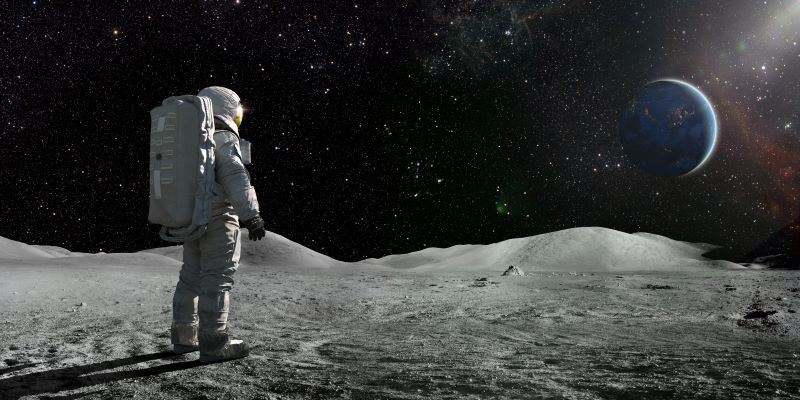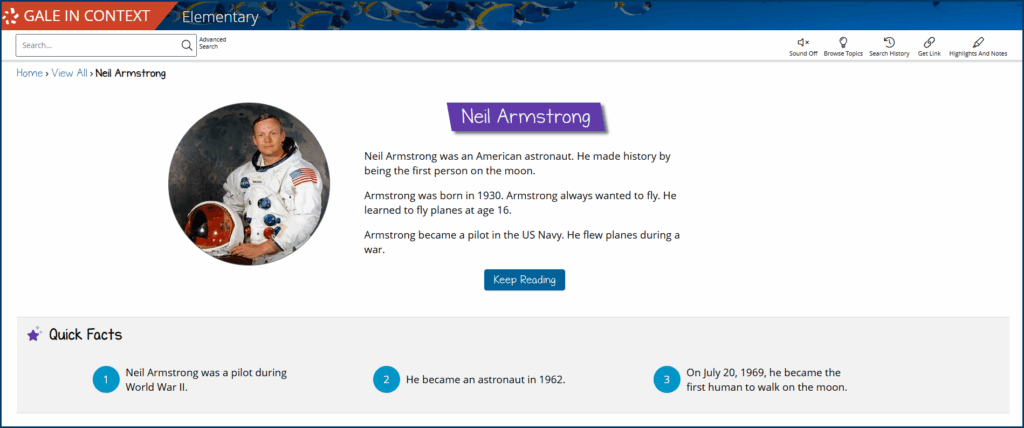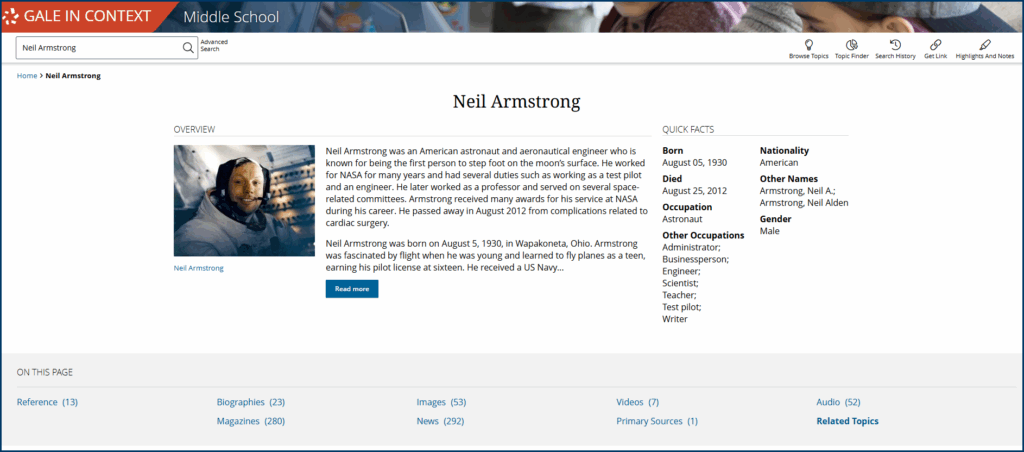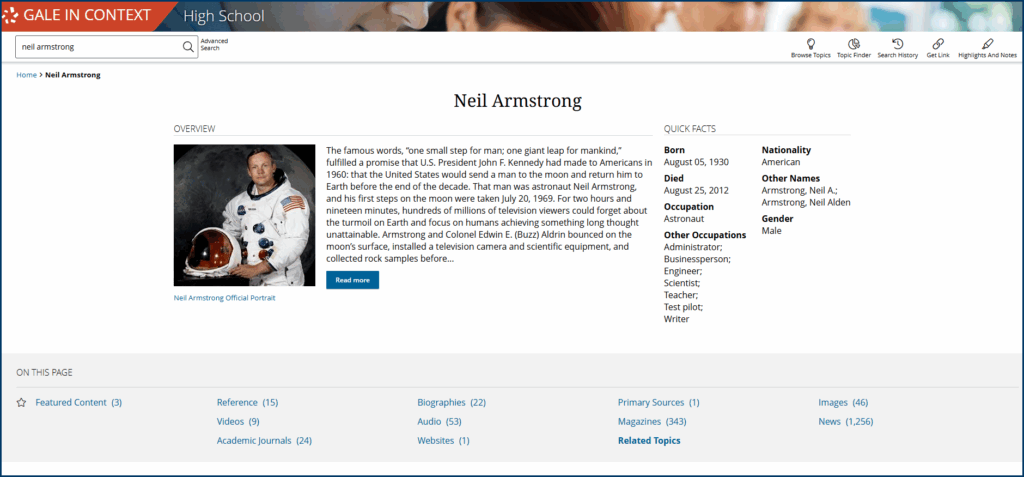Space exploration is a high-risk endeavor, demanding substantial financial investment and meticulous calculations. Since the first successful manned launch in 1961, more than 700 people have traveled to outer space; these astronauts have demonstrated courage and resilience in the pursuit of knowledge.
Two of the early pioneers in the Space Race hailed from Russia. In 1961, Yuri Gagarin was the first person to orbit the Earth, and in 1965 Alexei Leonov was the first to complete a space walk. But it wasn’t until 1969 that Neil Armstrong became the first person to set foot on the Moon, whose “small step” created a “giant leap for mankind.”
For students at any age, Armstrong’s birthday on August 5 is a great opportunity to reflect on his life and legacy. Gale In Context houses grade-appropriate information on his upbringing, career, and accomplishments, providing a strong foundation for exciting classroom research and discussions.
The Boy Who Was Born to Fly
Neil Armstrong was born in Ohio in 1930 during a period of immense hardship in the United States. While the Great Depression defines the decade still today, the Dust Bowl led to massive crop failures and the displacement of thousands of American families.
Armstrong was a naturally inquisitive and gifted child. At the age of six, he rode in a Ford Trimotor, a noisy, all-metal aircraft. Flight fascinated Armstrong, and he developed an early aptitude for engineering and constructing his own model airplanes.
As a teenager, he began taking flying lessons, earning his pilot’s license at the age of 16. Soon after, Armstrong enlisted in the US Naval Reserve and earned a Navy scholarship to attend Purdue University, where he studied aeronautical engineering. As part of his scholarship, Armstrong was called into active duty in 1949, shortly before the Korean War broke out. The 21-year-old flew in 78 combat missions.
Armstrong returned to Purdue in 1952 as a decorated military pilot, and completed his degree. After graduation, the National Advisory Committee for Aeronautics (NACA) recruited Armstrong as a civilian test pilot. In the late 1950s, as the international Space Race accelerated, NACA became the National Aeronautics and Space Administration (NASA).
The First Civilian Astronaut
President John F. Kennedy was a champion of early space exploration. Recognizing that NASA’s success relied on substantial public support and a diverse range of expertise, he urged NASA to expand its cosmonaut program beyond its military scope—thereby creating the opportunity for a civilian astronaut. Unsurprisingly, Armstrong was one of the first in line.
By his mid-30s, Armstrong was a NASA astronaut, actively preparing for his first space flight on the Gemini 8 mission. Gemini 8 signaled a significant milestone for the US space program; its goal was to rendezvous with a 26-foot Agena rocket, creating the first-ever space station. The initial mission was a success, but a wiring malfunction caused the linked crafts to spin out of control.
Luckily, Armstrong’s training as a military test pilot kicked in, and he quickly disconnected the Gemini from the Agena rocket and initiated an emergency landing. Despite having to abort the mission, Armstrong’s poise and quick thinking impressed NASA.
One Small Step for Man
In 1969, NASA selected Armstrong as commander of the Apollo 11 mission, the space flight destined for the Moon. The Saturn V rocket launched from the Kennedy Space Center on July 16 carrying a three-man crew, including Edwin “Buzz” Aldrin and Michael Collins, and they entered lunar orbit three days later. On July 20, Armstrong and Aldrin navigated a lunar module, named the Eagle, from the shuttle to the Moon’s surface.
The initial landing trajectory proved unsafe, forcing Armstrong to manually pilot the module across the Moon and select a different location. Despite the unknowns, the men descended to the lunar surface, reporting the immortal words to NASA command: “The Eagle has landed.”
An estimated 650 million people worldwide watched the broadcast as Armstrong stepped down onto the Moon. While on the lunar surface, he and Aldrin collected samples, set up research equipment, and raised an American flag. They even left a plaque that read, “We came in peace for all mankind.” With Armstrong at the helm, the Apollo 11 crew propelled modern science forward and forever altered human history.
Engage Elementary Students
Ready to help your students take giant leaps of their own? Keep exploring with help from Gale In Context: Elementary, a unique learning tool for K-5 students that helps foster their curiosity and research skills. The database is customizable for a range of learning styles and reading levels, helping students build their classroom confidence.
Your early learners can discover topic pages about the fascinating Apollo program and its triumphant Moon landing, as well as content from Armstrong’s biography that emphasizes his relatability. His friends described him as a “regular guy,” a fact that can help students see themselves in his story—and perhaps form a personal connection to his journey.
Research Activity
Using Gale In Context: Elementary, have students read Armstrong’s biography; ask them to reflect on what they think made him so extraordinary. Then, encourage students to find three similarities between themselves and Armstrong. For example, he was born in Ohio, he was an active member of the Boy Scouts, and his father’s job as a civil servant meant the family moved frequently.
Have students share the connections they make. By helping children relate to their role models, they develop a foundation on which to pursue their own goals.
Ignite Middle Schoolers’ Research
Your middle schoolers are ready for more in-depth research, and Gale In Context: Middle School provides a platform that encourages them to explore their interests further.
Armstrong was a natural when it came to flight—he was brave, resilient, and so determined to learn how to fly that he paid for his own lessons. With Gale In Context: Middle School, your students can explore the pathways that led hundreds of other brave men and women into outer space. They can find dozens of biographies of other accomplished individuals in the field, including John Glenn, Christina Koch, and Sally Ride.
Research Activity
Encourage students to broaden their research into other space missions, before or after Apollo 11. Have students identify the scientific objectives of the mission. Research which astronauts flew on the mission, what types of experiments they conducted, and how the mission contributed to the scientific community. To summarize their findings, students can create a poster, report, or multimedia presentation.
Encourage Debate Among High Schoolers
Gale In Context: High School contains thought-provoking materials designed to challenge students and instigate deeper conversations.
The space race defined a period of intense patriotism and scientific accomplishment. Still, it was also a calculated and expensive political endeavor that exacerbated ongoing tensions between the US and the Soviet Union. How do your students feel about the current state of space exploration? Do they support expanded funding and public assistance for the industry? How do they feel about the private sector’s growing role?
Research Activity
Want to spark classroom discussion and debate? Take a look at these conversation starters to help your students understand the pros and cons of space exploration. While the industry contributes immensely to our innate human curiosity and scientific understanding, it’s also costly and dangerous. NASA’s current Moon mission could push $100 billion; that’s a hefty price tag when one considers the many Americans who struggle to afford basics like housing and healthcare.
Neil Armstrong’s first step onto the Moon ignited the world’s collective imagination. His story shows how resilience and hard work ultimately overcome danger and fear. With NASA eyeing a return to the Moon with the Artemis program, you have an opportunity to invigorate a “new generation of explorers.” Inspire your students to follow their imagination and begin their own journey with dependable, educator-trusted content from Gale In Context.
If your school district is not a current Gale subscriber, contact your local representative to request a product trial.




